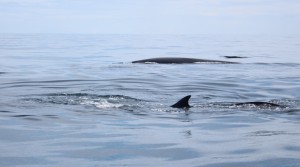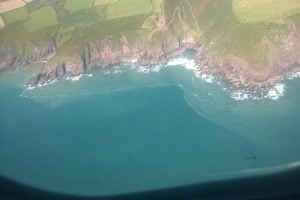
The intense plankton has diminished somewhat but is still keeping the water clouded green in colour, and providing sustenance for an enormous amount of whitebait. Whilst a lot of it is tiny, too small to be of interest to large whales, it is growing rapidly in the surface layers of the sea, warmed by good periods of strong sunshine and warm summer winds. The warmer the water, the faster the growth. It’s a good few years since there was so much pelagic fish in the seas off West Cork. There are now large shoals of bait fish forming 5 or 6 miles offshore and this has not gone unnoticed by the cetacean population.
For the past week there has been 20 to 30 fin whales Balaenoptera physalus feeding on these shoals, deep in the water column, with an unknown number of minke whales and hundreds of common dolphins in association. I have never seen so many large whales in August before. Large whale numbers normally peak in October- November, so having so many whales to watch in high season is most unusual.
On most trips out of late, the fin whales have formed pods of 5 or 6 together and these make for first class whale watching, with the dolphins sporting along with the boat and then skittering over to the whales when they surface for air, crowding on top of them, often jumping over them. The minke whales have started to lunge feed at the surface during the past week or two, adding to the excitement. This activity draws the attention of thousands of manx shearwaters, gannets, and a host of auk and gull species, as they drift around the whole area looking for an easy beak full of fish. The presence of seabirds is a dead giveaway as to the whereabouts of the feeding minkes, that seem quite happy to hoover up the smaller whitebait at the surface, whilst the fin whales plunge to depths of 60-70 metres for their prey.
As of yet I’ve not found a catchable bait- ball to examine the content of the bait fish, that I suspect may be largely composed of small / immature herrings, but hopefully any day now the opportunity will arise. From previous experience, whenever there has been good numbers of fin whales, humpback also appear out of blue to join in the action. I’m sure it’s going to be a really interesting whale watch season as we move into the autumn……..
Colin Barnes
Skipper, MV Holly Jo


2 comments
Whale Watching Tours
Watching the whales enjoying their natural habitat is a wonderful thing- you can never get bored of this. Manly whale watching help you to see them playfully enjoying themsleves in nature, breaching, rolling and tail lobbing is a breath taking and memorable experience.
Whale Watching Tours Sydney
Australia is one of the best places in the world to see whales. Whale Watching is a fantastic way to experience the excitement of pure nature like never before. There are many whale watching tours in Sydney available online.
Comments are closed.